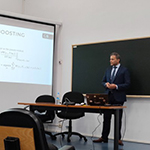The primary advantage of LSTM over traditional RNNs lies in its ability to selectively retain and
forget information over extended time intervals. This is accomplished through the use of specialized
memory cells, which are capable of storing information for long periods without degradation. As a
result, LSTM networks are
...
Accuracy: This measures the proportion of correct predictions made by the model, i.e., the number of
true positives and true negatives divided by the total number of instances in the dataset.
Precision: This measures the proportion of true positive predictions (i.e., the number of correct
positive predictions) among all positive predictions made by the model. High precision means that
the model makes few false positive predictions.
...
The EMD algorithm involves decomposing the signal into a series of IMFs, which are obtained through
a process called sifting. Sifting involves identifying the local extrema of the signal and fitting
an envelope to this extrema. The difference between the signal and its envelope is then computed,
and the process is repeated on the difference until a locally smooth IMF is obtained.
The resulting IMFs
...
Data segmentation in computer vision can be done in various ways, depending on the specific task and
the nature of the dataset. Some common techniques include:
...
Light GBM (Light Gradient Boosting Machine) is a popular open-source framework for gradient
boosting, a powerful machine learning technique for building predictive models. Gradient boosting is
an ensemble method that combines several weak learners (e.g., decision trees) to create a strong
learner that can make accurate predictions on new data.
...
